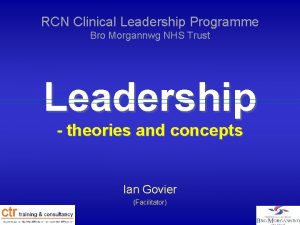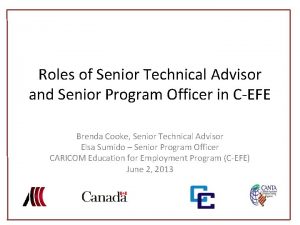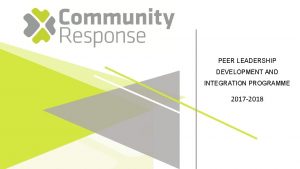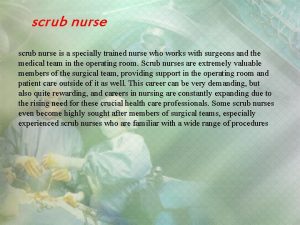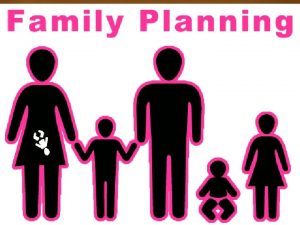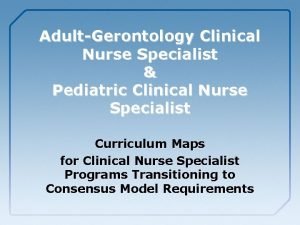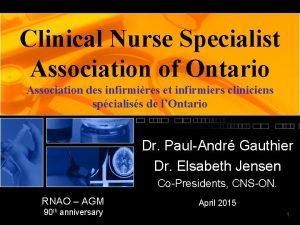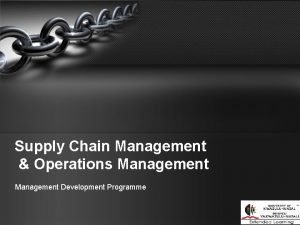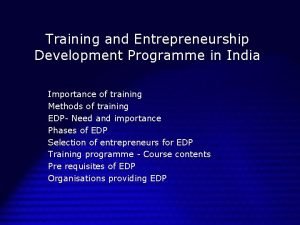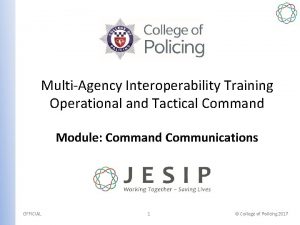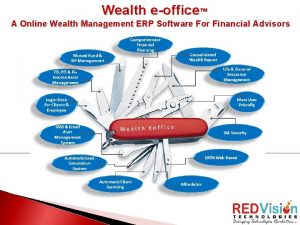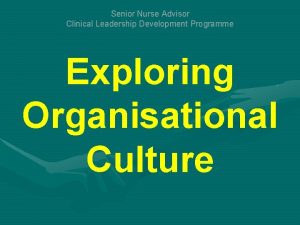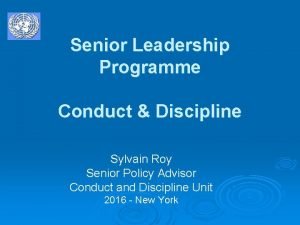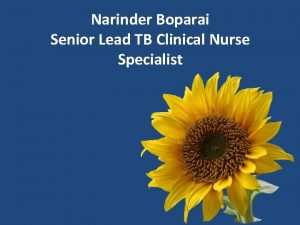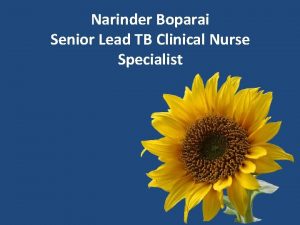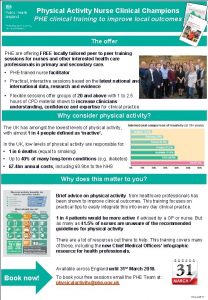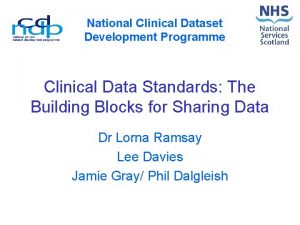Senior Nurse Advisor Clinical Leadership Development Programme Developing























































- Slides: 55

Senior Nurse Advisor Clinical Leadership Development Programme Developing & Sustaining Effective Teams Ian Govier (Facilitator)

Are we thinking the same thing? ELEPHANT

Aim of the Programme To assist the clinical leadership development of Senior Nurse Advisors at NHS Direct Wales

Programme Objectives The Programme will assist participants to develop their clinical leadership potential through: • Active participation in clinical leadership workshops and related activities; • Identifying and critically examining the key characteristics, attitudes and behaviours associated with effective clinical leadership; • Taking action to successfully lead the Nurse Advisor team and thereby enhance the performance and quality of health care provision provided by NHS Direct Wales.

Senior Nurse Advisor Clinical Leadership Development Programme Introductory Days x 2 Clinical Leadership an introduction to practices and principles July 25 th & 26 th Module 1 Clinical Leadership September 5 th developing & sustaining effective teams Clinical Leadership September 6 th exploring organisational influences Module 2 Clinical Leadership October 24 th leading and implementing complex change Clinical Leadership October 25 th managing performance & improving patient care

What do you want to ACHIEVE or CHANGE as a result of today?

To explore how we can develop & sustain Effective Teams

Explore our team roles Revisit the ‘constants’ Examine our team values To explore how we can develop & sustain Effective Teams Refer to and discuss relevant team research Explore our team dynamics Identify characteristics of effective teams

Healthcare Leadership & Management The Challenge



Permanent White Water (Vaill, 1996)


The Constants ü Change ü Principles ü Choice (Covey, 2006)

Developing & Sustaining Effective Teams - principles

Leadership in the new millennium has comprehensively come of age. Where once leaders were aloof decision-makers, today they are dedicated collaborators whose role is to give power to their TEAM rather than wield power to their own ends. Leaders on Leadership– an intimate view of life at the top of Europe plc Development Dimensions International (DDI) Research Report, January 2006

What is a team?

A team is more than just a group of individuals who work together. A team is a small number of individuals with complementary skills committed to a common purpose, common performance goals and an approach for which they hold themselves collectively accountable. (2007)

A team is a group of individuals who work together to produce products or deliver services for which they are mutually accountable. Team members share goals and are mutually held accountable for meeting them, they are interdependent in their accomplishment, and they affect the results through their interactions with one another. Because the team is held collectively accountable, the work of integrating with one another is included in the responsibilities of each member. (Mohrman and Cohen, 1995)

Teams possessing the following characteristics are more effective in delivering high quality care: • clarity of team objectives • high levels of participation from all team members • high emphasis on quality • high support for innovation Health Care Team Effectiveness Project (Borrill and West , 2002)

What are some of the characteristics of an effective team? Group Work

Defend or Destroy! Group Exercise

In health care terms, what difference does team working really make?

Borrill & West (2002) found that individuals who worked in well functioning teams had lower levels of stress and better mental health. Their research demonstrated a significant relationship between the percentage of staff working in teams and patient mortality. Where more people work in teams, the death rate among patients is significantly lower. There is much to be gained by enhancing team functioning and effectiveness!

It Takes a Team Coming together is a beginning Keeping together is progress Working together is success John C. Maxwell

Task Action Centred Leadership Team Individual John Adair (2002)

Achieve the Task Build the Team Develop the Individual Action Centred Leadership

How do we motivate teams to action?

The ‘ 8 Rules’ for Motivating People: • Be motivated yourself • Select motivated people • Treat each person as an individual • Set realistic but challenging targets • Understand that progress itself motivates • Create a motivating environment http: //www. teambuilding. co. uk/john_adair. html • Provide relevant rewards • Recognise success

‘Number Cruncher’ Group Exercise

“That which we persist in doing becomes easier - not that the nature of the task has changed, but our ability to do has increased. ” Ralph Waldo Emerson

Real teams do not develop until the people in them work hard to overcome the barriers of collective performance. Overcoming barriers to performance is how groups become teams. Katzenbach (1993)

The 3 important roles of a Team Leader Initiator beginning actions and processes that promote team development and performance Model shaping behaviour and performance that reflects the expectations set for the team Coach serving as counsellor, mentor and tutor to help team members improve performance

How am I doing as a Team Leader? Team Leader Checklist

What is my contribution to the team? Team Role Audit

Code of Conduct for NHS Managers • Patient-centred • Accountable • Performance oriented • Responsive to local needs • Equal, diverse & values inclusion • Partnership focused National Assembly for Wales (2006)

What are the underpinning Values that exist in our team? Team Values Exercise

TEAMS - a ‘vehicle’ for service delivery and improvement

Where am I with my team at the moment?


Choosing our ‘team’ vehicle



Which vehicle represents our team, & why? Is it a +ve or -ve image? How do you think others perceive you and your team in terms of your vehicle? Who drives this vehicle? Do you change position? How comfortable are you? Who else sits in this vehicle? Do you want to change your vehicle?

Final Thoughts

The Constants ü Change ü Principles ü Choice (Covey, 2006)

What am I doing to become a transformational team leader?

What am I (are we) going to do differently after today?

If we always do what we’ve always done… …we’ll always get what we’ve always got!

The ‘Trim Tab’ effect

HMS ‘Trim Tab’

Be a TRIM TABBER!

and finally…

If we do nothing about it in 24 hours… …we’ll probably do nothing about it!

Diolch Website: www. ctrtraining. co. uk http: //www. ctrtraining. co. uk/resources. php Thank You
 Rcn clinical leadership programme
Rcn clinical leadership programme Senior technical advisor
Senior technical advisor Peer leadership development programme
Peer leadership development programme Mrc career development award
Mrc career development award Responsibility of scrub nurse
Responsibility of scrub nurse Nurse logic ati
Nurse logic ati Future nurse programme
Future nurse programme Objectives of family planning
Objectives of family planning Pediatric clinical nurse specialist programs
Pediatric clinical nurse specialist programs Clinical nurse specialist ontario
Clinical nurse specialist ontario Heather candler
Heather candler Senior youth leadership logo
Senior youth leadership logo Developing your leadership philosophy
Developing your leadership philosophy Developing a leadership philosophy
Developing a leadership philosophy Personal leadership philosophy worksheet
Personal leadership philosophy worksheet Edward jenner programme
Edward jenner programme Dev chanchani
Dev chanchani Black business supplier development programme
Black business supplier development programme Krishi darshan history
Krishi darshan history Supply chain development programme
Supply chain development programme Firka development programme
Firka development programme Comprehensive rural development programme
Comprehensive rural development programme Feedback for faculty development programme
Feedback for faculty development programme Entrepreneurship training and development
Entrepreneurship training and development Objectives of community
Objectives of community Integrated residential development programme
Integrated residential development programme Transactional leadership vs transformational leadership
Transactional leadership vs transformational leadership Adaptive leadership style
Adaptive leadership style Adaptive leadership vs situational leadership
Adaptive leadership vs situational leadership Clinical pharmacy definition
Clinical pharmacy definition Fp advisor uqam
Fp advisor uqam Uwb advisor appointment
Uwb advisor appointment Umr nurse line
Umr nurse line Uncc transfer credit advisor
Uncc transfer credit advisor Fidelity advisor 529 plan
Fidelity advisor 529 plan Siss
Siss Ramon magsaysay contribution
Ramon magsaysay contribution Norco community college classes
Norco community college classes Airwave tactical advisor
Airwave tactical advisor Ics academic advising
Ics academic advising Hpe right mix advisor
Hpe right mix advisor Financial advisor for startups
Financial advisor for startups Family and community health advisor
Family and community health advisor E office mutual fund
E office mutual fund Ucf
Ucf Recommended on tripadvisor
Recommended on tripadvisor Pdg advisor
Pdg advisor Sports compleat advisor
Sports compleat advisor Pcc advising
Pcc advising Academic advisor uf
Academic advisor uf Motor teknologi & industri sdn bhd
Motor teknologi & industri sdn bhd Ibm mssp
Ibm mssp Webadvisor cabrillo
Webadvisor cabrillo Thingworx manufacturing apps
Thingworx manufacturing apps Ffa advisor symbol
Ffa advisor symbol Who is the virginia hosa state advisor?
Who is the virginia hosa state advisor?
